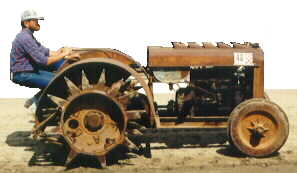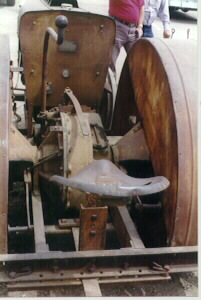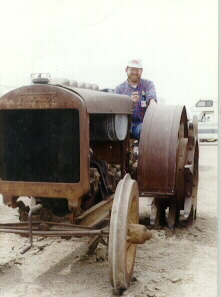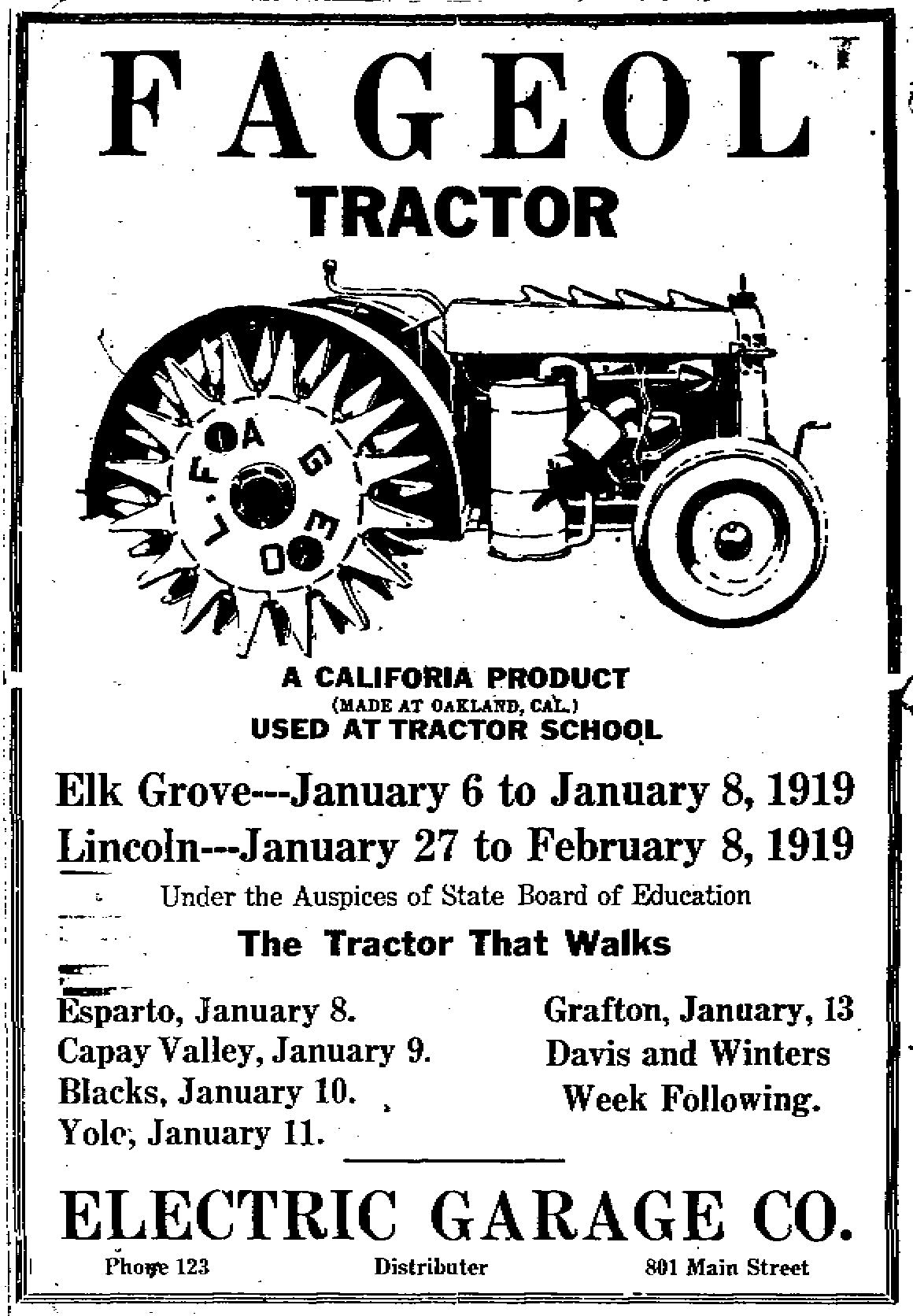

The California-made Fageol tractor was produced in Oakland by the Fageol Motor Company from 1918 through 1923. In 1924, production shifted to the Great Western Motor Company in San Jose, where a limited number of tractors were produced over the next two or three years. My Fageol, pictured above, is one of the Great Western series and is serial number 16035. The Fageol company also built trucks and buses, which also had the distinctive sawtooth hood. They seemed to be more successful at building trucks than tractors and later evolved into the Peterbilt Company.
Fageol tractors seemed to have been designed as cheaply as possible. They used a four cylinder Lycoming truck engine. This was coupled directly to the one speed forward, one speed reverse transmission with no clutch! There is also no differential in the final drive. Instead there are foot operated steering clutches that are linked to expanding friction bands inside each rear wheel. The tiller bar is ineffective on tight turns due to the lack of a differential and require the use of the steering clutches.

The oddest thing about this tractor and what puzzled me the most when I acquired it was the fact that I could not find a clutch anywhere. Was I missing something? I almost hated to ask anyone for fear that I would be ridiculed for not seeing it right out there in front of me! But this tractor does not have a main clutch. How then does one shift into gear? This continued to puzzle me until I carefully read the instruction manual under the paragraph:
Starting Tractor After Motor
Is Running
To start the tractor moving with the motor running, take the operator's
seat. Place both hands on gear shift lever bar. Press both [steering]
clutch pedals down as far as they will go, then to go into forward
gear, push right hand forward and pull with left. Do this with
a quick motion to avoid rasping gears. Allow the clutches
to come up evenly and Tractor should get away in a straight line.
(Italics mine)
The secret appears to be in grinding the gears together as quickly as possible!

No production data seem to have survived, so it is unknown how many tractors were ever produced. A listing I have made contains about twenty four known Fageol tractors. They were poorly designed, difficult to use, and easy to get stuck. Most of them have probably been scrapped a long time ago. The Fageol was a tractor typical of the times, which saw several hundred manufacturers creating many innovative but often impractical designs. The ranks of these builders dwindled rapidly during the recession of the mid 1920's. The handful of survivors needed both the best designs and sufficient financial backing to produce and sell enough tractors to be profitable.
This tractor was used by John F. Kiely (1904-1992) for dry land farming in the Livermore area of California. The original owner was John Kiely's uncle, Henry Hartmann (1865-1938), who was a pioneer farmer in the Livermore Valley. I purchased the tractor in August 1993 from Mr. Kiely's sons, John, Hugh, and Dennis Kiely.
Floyd Percival, Stan Gladney, and Elmer Goltz helped me get the tractor back into running condition. This is the only one I know of with rear wheel extensions. In addition, the seat, pedals, shift lever, and tiller bar are all mounted farther back and lower than on most other Fageols - probably making this an orchard model. I still need to restore the large water filled air cleaner, but I plan to keep the tractor is its otherwise "as found" condition. It runs very well (probably because it had not been used enough to wear it out!). I have had it on display at the California State Fair in Sacramento for the last few years.

The history of the Fageol tractor and other Fageol products is not only tied in with many companies, including Rambler and Nash, but also contains a great many twists and turns. If World War I had not come along and involved the United States, perhaps Fageol tractors would have become one of the most popular names in farm tractors; as it was, when the war came, Fageols were smart enough to understand that with men leaving for the war, the demand for tractors would be down. As the Oakland Yearbook of 1928 said, "A great Oakland manufacturing plant stands today as testimony to the fact that industrial and national history are inseparably related, notably in case of war. Of the many manufacturing concerns which had their development radically affected by the World War into which the United States entered in 1917, Oakland boasts at least one plant in which the war brought about the manufacture of an entirely different product than that for which the factory was originally designed."
That company, of course, was Fageol Motors Company. Making major changes in their products meant they survived the war years (unlike many other companies that didn't adjust), but it apparently dampened their enthusiasm for tractors, -or just pointed out other products they liked to make more.
The saga began in the Midwest, when Frank R. Fageol was born near Ankeny, Iowa, in 1882. By the time Frank and his brother William were in their teens, you could see that they were something special. When Frank was 17 and Bill 19, they had built what was said to be the first automobile in Iowa, a steam-driven vehicle that held eight passengers.
Their- business acumen became apparent early. They filled the car with passengers, and for a fee, motored it about ten miles to and from Ankeny Iowa to the state fair near Des Moines just before the turn of the century.
Neither the Ankeny Public Library
nor the area historical society had any information at all about
the Fageols. Little more is known of the early life of either
Fageol until Frank headed west to San Francisco in 1904.
In San Francisco, Frank hooked up with Louis H. Bill and Bill's
brother, T.R., midwestemers who had emigrated from Ohio about
five years earlier and had, with friends, set up the California
Motor Co. to build and market the California motorcycle. This
company was later moved back to Ohio, so Louis Bill, who stayed
behind, needed another job, and thus became the San Francisco
agent for the Rambler car (at 1331 Market Street in SF), and in
1905 Frank Fageol was hired by Louis Bill. Frank Fageol applied
for a chauffeur's license in that year, using the address of the
Rambler agency as his place of employment. William Fageol soon
joined him and Louis Bill.
Louis Bill moved up rapidly, and became the Rambler Pacific Coast distributor. In 1906 the San Francisco earthquake struck, and Louis Bill offered Frank Fageol the Rambler agency in Oakland; shortly thereafter, Louis Bill was offered a factory post, which he took, and Frank Fageol moved up, replacing him as the Rambler distributor. The Fageol brothers operated their agency out of a tent for a while--probably because of the earthquake--but in 1906 or '07 moved into a frame building.
Other Fageols followed the brothers out to California. As Motor Coach Age says in a November/December 1991 article by Eli Bail, "City directories for the 1907-1916 period list a number of other people named Fageol too. In the listings for 1907, 1908, and 1911 (1909 and 1910 are not available), Frank Fageol is identified as president of United Electric Vehicle Co., and agent for Rambler automobiles. William is listed as foreman, Rollie B. and Claude H. as machinists, and John J. as a salesman. United Electric Vehicle Co. may have been the predecessor of the Eight Wheel Motor Vehicle Co., which was established in 1918 to build gas-electric ore carrying trains and whose patents were used by the short-lived National Axle Co. for eight-wheeled trucks and buses after 1920."
In 1912 all the Fageols listed in area directories had some association with the Fageol Motor Sales Co. By now, Fageols distributed Garford trucks and Rambler cars. Rollie's name is no longer associated with the company in 1913, and John's disappeared in 1914. Perhaps the Fageols had begun discussing the possibility of building a tractor, and some of the Fageols didn't like that, but that is just speculation. C.R. Tate was the manager of the Fageol Motor Sales Co. dealership, which sold Ramblers.
The Thomas B. Jeffery Co. built Ramblers from 1903 until 1913. When Thomas Jeffery died in 1914, his son Charles renamed the car "Jeffery" in his honor. A couple of years later Charles Nash bought the Jeffery company, and took over Frank Fageol's retail and distribution operation as a company store, although Frank retained another garage building nearby. Nash also fired Louis Bill, who then rejoined the Fageols as a major investor in the newly-formed Fageol Motors Co.
Though the Fageols' first love was probably automobiles, when the 1915 Panama-Pacific Exposition took place in Golden Gate Park, Frank Fageol turned his eyes to the possibility of another way of making money, and built a fleet of trains that carried sightseers around the grounds.
J.H. Fort writes in The Fageol Success, "When the Panama-Pacific Exposition was being planned, the problem of transportation within the grounds confronted the directors. Many proposals were submitted and considered, but none seemed as practical as that of R. B. Fageol and F. R. Fageol. The latter, over a period of fifteen years, had been automotive inventor, mechanic, and salesman.
"The Fageols proposed to solve the problem by building a small tractor, using the motor of a popular automobile, to draw the passenger trailers. The idea amused and appealed to the directors; the Fageols were awarded their transportation concessions"
These trains actually were
the first Fageol (or as the financier Edward P. Brinegar, who
was putting tip the money for the project, required the brothers
to call themselves, "Fadgl", which was printed plainly
in large letters on the vehicles,) tractors. ("Fadgl"
because people had such difficulty with pronouncing the name.)
The tractors to be used to pull specially constructed open-sided
trailers around the grounds, used Ford car motors for power. Each
trailer held 20 passengers, and was built in Frank Fageol's auto
agency, financed by Brinegar, who was an automobile dealer who
held the transportation franchise for the Exposition. The company
was called Fadgl Auto Train, Inc., with offices in San Francisco
and shops at Frank's Oakland facility. A prototype was built,
and along with the tractors that were finally used to pull passengers
during the Exposition, looked more like a small car, with four
small wheels, barrel-shaped hoods and large mesh filled front
bumpers. The wheels of the trailers were shrouded so passengers
wouldn't catch clothes or feet in the spokes as they sat in the
small cars with their legs dangling off the edges. If they stretched,
they could touch the ground with their feet. A. sightseeing trip
cost the princely sum of 10 cents, and the project was a huge
success. After the exposition, the trains were shipped to Chicago
and used in Lincoln park.
Because of that success, the Fageol brothers decided in 1917 that they would build their own factory. Automotive Industries, Volume 37, 1917, says "Oakland, Cal., June 30--The Fageol Motors Co. has started work on the first unit of its new factory for passenger cars, trucks and tractors in this city. The plans of the new plant are for a factory capable of producing the several lines of trucks, tractors and cars, and will be built in a series of units to accommodate this purpose. "
Pacific Service Magazine of June. 1917, says "Ground was broken June 10th for the Fageol Motors Company at One Hundred and Sixth Avenue and Boulevard, Oakland, under the auspices of the Oakland Chamber of Commerce. Some 2,000 people were in attendance. The ceremonies were opened by Jos. Chrystostomo, power sales engineer of Pacific Service. ....The company will build military and farm tractors and marks the second large motor factory for Oakland." No more mention has been found of the "military" tractor Fageols were going to build.
The tractor the Fageols did build was the invention of Rush Hamilton of Geyserville, California. Hamilton had patented it in 1915 (along with other patents), and formed the Hamilton Tractor Co. It was an odd looking orchard tractor, the purpose of which was to tow wagons. Al says, "Unlike either the caterpillar or broad wheel type of tractor, or the convertible automobile tractors in common use today, (like the Staude Mak-A-Tractor or Smith Form-A-Tractor) the Hamilton machine uses an entirely new principle for getting its traction. Instead of flattening the ground in front of the plow or harrow or other machinery being pulled, this tractor draws its farm implements along after having loosened up the soil by its front wheels with their long blade-like teeth."
Fageols claimed the blades,
or teeth, on the front wheels of the tractor enabled it to walk
right over all kinds of ground, and claimed the machine could
go almost any place the farmer or orchardist wanted it to go.
Rights to the Hamilton invention had been acquired, and would
be manufactured as soon as the new factory was built and the machinery
installed. Officials of the new company, Fageol Motors Co., included
L. H. Bill, president; Frank R. Fageol, secretary and manager.
Directors, Rush Hamilton, Dr. Arthur E. Hackett, W.B. Fageol,
and Horatio W. Smith.
Nick Baldwin writes in Vintage Tractor Album Number Two, "The first (Fageol) tractor was basically a two-wheel power plant with a ride-on dead axle at the rear steered by gearing around a quadrant at the back of its frame. A plate on the front described it as the Hamilton tractor... The tractor was described by the British technical press in 1917, although whether any of them were imported into Britain is unknown, but is unlikely. It cost $1,085 in its homeland, where it was classed as being equivalent to a four-horse team. It had a pressed steel frame, four-cylinder engine and drive to the wheels by internal gearing, all of which ran immersed in oil. Despite weighing only 1,730 pounds, it exerted a considerable drawbar pull, thanks to special chisel-like strakes, which could be covered with bands for road traveling."
The orchard tractor was called a "walking tractor", and the spiked driving wheels did work. A company called Butler-Veitch contracted for all of the Fageol orchard tractors, (although it's unclear how many that might have been), and Fageol became a sales agent for Butler-Veitch in Oakland in 1918.
In 1918 that orchard tractor was followed by a true four-wheeled tractor, rated a 9-12, (R. B. Gray, in The Development of the Agricultural Tractor in the United States, calls it an 8-12) with the trademark "spudded" drive wheels, which had metal stakes protruding on either side of the wheel and made it look like a gigantic cogwheel.
Gray writes that "The Fageol 'walked' on its 'legs' or grousers. It was claimed that because of the wedging action of the ground between two adjacent grousers, the drive wheels would not sink deeply even in loose sand. In the drum of each driver was an internal expanding clutch which coupled the solid live axle to the drive wheel; no differential on the axle."
Baldwin writes, "This had a Lycoming four-cylinder 3 1/2 x 5-inch bore and stroke engine and only one forward gear. Steering was by tiller, and an enormous replaceable filter air cleaner took care of the California dust. The carburetor was by Tillotson, and magneto ignition by Dixie. The whole transmission was generously provided with ball and roller bearings, Total weight was 3,600 lbs. (more than double the orchard tractor) and the price was correspondingly high, ($1,525 in 1922) which results in few sales..." The vents on the hoods of the Fageol tractors were very distinctive, like other Fageol vehicles of the time.
Pacific Service Magazine wrote in its March, 1922 issue, "Delivery of tractors for farm and vineyard purposes began in 1918. Foreign trade was developed until now the company supplies the Pacific Coast and is sending its tractors to the Pacific Islands, many countries of Europe and the far east.
"At present the Fageol Company is putting out a new type of highway maintenance trucks, passenger busses and stages. The Fageol inter-city stage was recently introduced. During the present year and next year the company will continue with its truck and tractor development and will bring out a full line of highway stages, gas street cars and deluxe cars for estates and ultrafine service. Approximately 105 employees are now employed at the Foothill Boulevard plant."
But alas. Despite the good words about the possibilities for Fageol tractors, in 1923 the factory ceased making Fageol tractors, during the heart of the agriculture recession, and probably closely related to it, partly because of fewer men on farms, the need to turn to other, more secure government contracts for making trucks, but perhaps more due to the high prices of the tractors with few corresponding additional features compared to the average orchard tractor. Why should an orchardist pay more for a tractor that didn't have additional features than other tractors on the market?
Because Fageol continued as a successful company, perhaps they wanted to forget about their stepchild the tractor, which wasn't so successful, because in the 1931 Oakland Tribune Yearbook, T. R. Bill says that the company was originally started in 1917 as a company "for the manufacture of a passenger car." Newspaper accounts from the time of the formation of the company make it abundantly clear that the tractor was as high a priority at the time as trucks and passenger cars.
After Fageol Motors Company quit making the tractors, it appears that a few might have been made in San Jose. Fageol Motors Co. director Horatio W. Smith owned National Axle Corporation in San Jose, where he lived at 484 South 9th. The corporation was organized in 1920 on 12 acres in what was formerly known as Luna Park, and built a large one-story building which cost $68,000, and an additional $115,000 was spent on equipment. In 1921 fifteen mechanics .were employed, but the company expected that to rise to 100 workers in the near future.
The plant was "obtained
by a new corporation," says the History of Santa Clara County.
S. C. Kyle was president, and Earl C. Fancher and H. W. Smith
were vice-presidents, with Smith as the manager of the works.
"Axles form the main output, though the factory is prepared
to do all kinds of contract work."
The building was 360 x 90 feet, and a hundred feet east of it
another Smith's ventures, Smith Manufacturing Company, was located
a 75 x 60 building, "and here is manufactured everything
in the line of boilers and sheet metal work."
"It appears," says Bob Johnson, Reference Librarian of the California Room of the San Jose Public Library, "that H. W. Smith somehow took over the company, renamed it, and began manufacturing tractors instead of axles."
The renamed company was Great Western Motors Company and appeared in 1924, the same year the last mention was made of Fageol tractors. "The company was also listed in the 1925 directory," Johnson says, as "Tractor manufacturers, 13th comer Berryessa Road." The company wasn't listed in 1926, was listed in 1927, but disappeared forever afterwards.
However, Smith is not listed after 1925, and Johnson surmises Smith died suddenly at that time. It isn't clear if Fageol tractors were built in San Jose, but some people believe at least a few of them were. Johnson adds, "I could not find any connection between the Great Western Motors Corp. and Fageol Motors. There was a dealer for Fageol Trucks and Tractors located in San Jose at this time, but nowhere near the Great Western facility."
Also, the Oakland Achievement for December, 1920, lists a new industry that came to Oakland in that year, and includes the Fageol-Moss Shock Absorber Company, with the very strong possibility that this company also had something to do with these same Fageols.
As Fageol Motors Co. branched out into their other products, selling trucks and busses to Australia, Java, Japan, China, Mexico, Guatemala, Canada, and many more countries, operating thirteen direct factory branches through the Pacific Coast area by 1931, tractor lovers can only wonder how widespread Fageol tractors might have become if its production had been feasible.
No Fageol orchard tractors survive, (although many people think there must be some around somewhere in California) nor did research turn up anyone who had worked at the old Fageol plants putting together Fageol tractors. The mists of time appear to have closed very tightly around a more detailed history of the Fageol tractor.